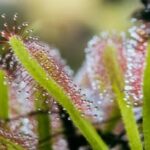As an Amazon Associate, this site earns commissions from qualifying purchases. For more details, click here.
Sundews are pleasing to the eye thanks to their rich, deep colors. The way they lure and capture prey makes them even more captivating to plant growers. But do these carnivorous plants have any scent? Does the plant smell good or will it leave a bad odor in your house?
Sundews produce a sticky dew-like substance that gives off a sweet, fruity scent. It is this sugary smell that attracts flies, ants and other insects to the plant.
What Do Sundews Smell Like?
Ask any sundew owner what the smell is like, and they will tell you it is difficult to describe. The odor is pleasant but difficult to convey in words. It is something you have to smell for yourself.
The best way to describe how a sundew smells is sweet. Some say it has a fruity scent while others say it is sugary. And there are those who think it is a combination of both. What all agree on is that sundews smell nice.
This smell comes from the mucilage, the dew-like stuff the plant has over its tentacles and leaves. The pleasant smell comes from this substance, not the leaves.
As nice smelling as this dew is, it has a very practical purpose. Sundew leaves and tentacles are covered by this stuff to lure prey.
Here you can see just how important insect nutrients are to sundews. Without nutrients, growing sundews becomes difficult.
The sticky properties of the dew serve as the trap. When an aphid is nearby for example, it will smell the fruity scent. It then gets drawn to the plant.
When the aphid tries to eat the dew, its body gets entangled in the sticky stuff. The tentacle where the insect landed pulls the prey deeper into the plant where it is consumed.
Sundews might take 15 minutes to kill a prey, but digesting could last for a week or two. Once the plant has absorbed the prey, its nutrients enter its system.
This is the exact same method sundews use for any food, alive or not. If you feed it Zoo Med Micro Floating Betta Pellets for instance, the tentacles will act the same way. no need to stimulate the trap either, just the fish pellets onto the dew and the plant does everything else.
This shows you why these plants have a sweet scent. Without the smell, there is no way for the plant to lure its prey. Yes sundews are carnivores just like some animals, but unlike those, these plants cannot hunt for food. So they have to find a way to lure these creatures to them. Nature provided sundews with the means to attract insects. By producing dew, insects get drawn to it.
Why Does My Sundew Smell Bad?
A foul smelling sundew is likely due to a rotting insect left in its trap. Other possible reasons for the unpleasant smell are bacterial infection, root rot or improperly mixed soil.
If your sundew has root rot, it could also produce an unpleasant smell. Knowing the various causes is necessary to find out the cause.
Rotting dead insect. Sundews try to eat as much of their captured prey as they can. This is necessary so the plant obtains its nutrients.
Sundews release enzymes that soften and dissolve animal tissues, making it easier for the plant to absorb it. The enzymes can dissolve fruit flies, mealworms and other small insects.
However, insects with hard shells are harder if not impossible to break down. If the enzymes cannot dissolve the shell, it will be left out in the leaves.
If your sundew is outdoors, the rain or wind will dispose of the remains. But if the plant is indoors, those leftover parts will eventually rot. As time flies the smell becomes pervasive. Fortunately, removing the insect should get rid of the smell.
Using the wrong soil. Never use fertilized soil for sundews. Rich soil is fatal to carnivorous plants and often irreversible. After just a few days, the plant will stop producing dew and refuse to eat. Its leaves will dry out and decay will set in. To be sure, we recommend using only sundew compatible potting media like Jessi Mae Carnivorous Plant Soil.
Bacterial or Fungal Infection. Root rot and other diseases can kill sundews if left unattended. Among the symptoms are leaves that turn brown, refusal to eat, no dew and a foul smell.
If your sundew smells bad, look for any leftover prey. If there is none and you are sure the soil is nutrition free, you have to consider the possibility the plant has been infected by bacteria or fungus.
Why Does My Sundew Have No Smell?
So now we know what sundews smell like and why sometimes they smell bad. But what if your drosera has no scent at all? Is this a good or bad sign?
If sundews do not produce a sweet, sugary smell, it probably lacks dew. This is also a sign the plant requires additional light.
The dew is responsible for the smell, so if your sundew has no dew it will not have any scent. And that is bad news for your plant.
Sundews need sunlight to produce dew. If your plant only has a little or none at all, relocate it to someplace with more light.
Natural light is the best option, 6 hours minimum but 8 up to 16 hours is the optimum. If sunlight is limited in your location, use another source like LBW Grow Lights. These are going to work too as long as it is focused on the plant 12-16 hours a day.
With enough light, water and nutrients, your sundew will start producing mucilage or dew. This could take a few weeks. But eventually the plant will start drawing insects and produce that sweet sugary scent.
If your sundew has sticky stuff but only produces a faint smell, that is normal. Some drosera variants have a stronger scent than others even if their dew production is similar.
It is possible that your sundew does smell but it is very faint. With some drosera you have to get really close to the plant to smell its nectar, maybe even an inch or so from the tentacles or leaves.
As you get nearer, the smell becomes noticeable. Sundews cannot harm you, but be careful not to get any of the sticky stuff on you while trying to detect its scent.
How to Keep Sundews Smelling Sweet
A sweet smelling sundew is a sign of good health, so it is important that you keep it that way. Here are some things that you can do.
- More light, more dew. The more dew, the stronger the scent. This also means more opportunities for the plant to catch insects. The best way to keep this is to provide adequate light for the plant.
- Enough water. The dew in sundews is comprised partly of water. So the plant needs sufficient amounts of it to keep producing. Do not overwater your sundew because this might dilute the dew.
- Provide enough nutrients. Sundews have to eat regularly. And those in the growing stage have to feed every week to continue growing. When sundews have enough nutrients, the plant has the resources to generate dew.
Sundews look and smell better in a stress free environment. If possible, keep your sundews with a 40-60% humidity range and temperature at 45-85 F. Some variants can handle higher temperatures and less humidity, so check the ideal growth scenario for your plant.
By providing nutrition, light, water and the right soil, you reduce the risk of infection and disease. In case your plant suffers an infection, check the roots for signs of rotting. If there are still healthy parts left, you can still save the plant.
Cut off all the rotted parts and repot the healthy remnants in a new container. Care for the sundew as you would your regular plant, and over time it should recover. The surest sign of a fully recovered sundew is if dew starts to appear on its tentacles and leaves.
Conclusion
Knowing the different facets of your plant is one of the keys to growing it successfully. This applies to sundews in particular as there are a lot of different species and variants. With this guide you should now have a decent idea of its scent.

My fascination with carnivorous plants began many, many years ago with Venus Fly Traps. Now I am more than happy to impart what I know with other enthusiasts and those who are curious about meat eating plants.



